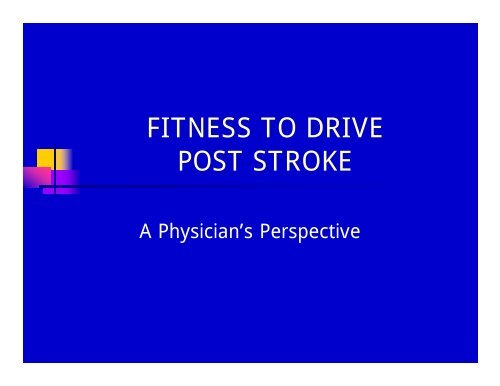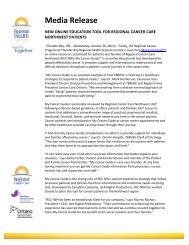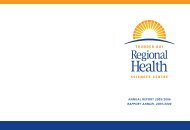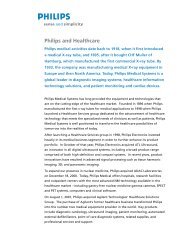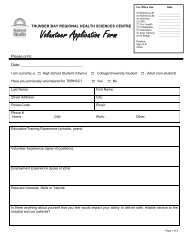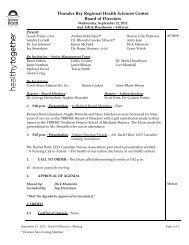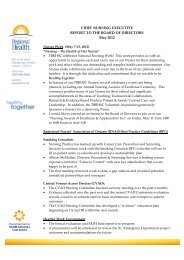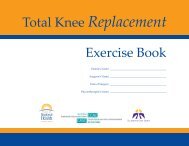Fitness to Drive Post Stroke: A Physician's Perspective
Fitness to Drive Post Stroke: A Physician's Perspective
Fitness to Drive Post Stroke: A Physician's Perspective
You also want an ePaper? Increase the reach of your titles
YUMPU automatically turns print PDFs into web optimized ePapers that Google loves.
FITNESS TO DRIVE<br />
POST STROKE<br />
A Physician’s <strong>Perspective</strong>
Conflict Disclosure Information<br />
• Presenter: Dr. John M. Hargadon<br />
• Title of Presentation: <strong>Fitness</strong> <strong>to</strong> <strong>Drive</strong><br />
<strong>Post</strong> <strong>Stroke</strong>: A Physician’s <strong>Perspective</strong><br />
I have no financial or personal<br />
relationships <strong>to</strong> disclose.
What does the Legislation have <strong>to</strong> say?<br />
Ontario Highway Traffic Act<br />
1990-Section 203<br />
1. Every legally qualified medical practitioner<br />
shall report <strong>to</strong> the Registrar the name,<br />
address, and clinical condition of every<br />
person 16 years of age or over attending<br />
upon the medical practitioner for medical<br />
services who, in the opinion of the medical<br />
practitioner, is suffering from a condition<br />
that may make it dangerous for the person<br />
<strong>to</strong> operate a mo<strong>to</strong>r vehicle.
What does the Legislation have <strong>to</strong> say?<br />
2. Ontario Regulation 340/94<br />
• Basic medical standards for all drivers<br />
• Must not suffer from any mental, emotional,<br />
nervous or physical disability likely <strong>to</strong><br />
significantly interfere with driving ability<br />
• Must not be addicted <strong>to</strong> alcohol or a drug <strong>to</strong><br />
an extent likely <strong>to</strong> significantly interfere with<br />
driving ability.
What does the Legislation have <strong>to</strong> say?<br />
3. Manda<strong>to</strong>ry reporting.<br />
• Ontario the first province <strong>to</strong> introduce<br />
manda<strong>to</strong>ry medical reporting 1968.<br />
• Response <strong>to</strong> physicians’ concerns about<br />
inability <strong>to</strong> persuade patients <strong>to</strong> s<strong>to</strong>p<br />
driving.
What does the C.P.S.O. have<br />
<strong>to</strong> say?<br />
• All manda<strong>to</strong>ry reporting constitutes an<br />
exemption <strong>to</strong> normal physician-patient<br />
confidentiality requirements. Breach of<br />
physician-patient confidentiality in these<br />
circumstances does not constitute<br />
t<br />
professional misconduct.
What does the C.P.S.O. have<br />
<strong>to</strong> say?<br />
• Conversely, not reporting something that is<br />
required by law <strong>to</strong> be reported can result in<br />
the imposition of fines and/or charges of<br />
professional misconduct.
What does the C.M.P.A. have<br />
<strong>to</strong> say?<br />
• Each physician involved in a patient’s care<br />
should be aware of and comply with<br />
legislative l requirements in their jurisdiction.<br />
• Where more than one physician is treating a<br />
patient there can be assumption that one of<br />
the other physicians has made a report when<br />
in fact no report has been made.
What does the C.M.P.A. have<br />
<strong>to</strong> say?<br />
• It is important <strong>to</strong> remember that it is the<br />
physician that makes the report but the<br />
decision about the restrictions is the<br />
responsibility of the Ministry of Transport.<br />
• Prior <strong>to</strong> making a report it is prudent <strong>to</strong> have<br />
a discussion with the patient about the<br />
physician’s s obligation <strong>to</strong> report <strong>to</strong> the<br />
authorities and the nature of the report.
What does the C.M.P.A. have<br />
<strong>to</strong> say?<br />
• Patients considered medically unfit <strong>to</strong> drive<br />
should be warned not <strong>to</strong> drive until a decision<br />
has been made by the Ministry of Transport.<br />
• All discussions and actions on the physician’s<br />
part should be documented.
What does the C.M.P.A. have<br />
<strong>to</strong> say?<br />
• Frequent diagnoses not reported:<br />
• Seizures – most common.<br />
• Alcohol and drug abuse.<br />
• Psychiatric disorders.
What does the C.M.P.A. have<br />
<strong>to</strong> say?<br />
• Average of 10 medico-legal cases per year:<br />
/ College complaints<br />
• \ Legal actions<br />
• Failure <strong>to</strong> report patient’s condition.<br />
• Patient’s complaints about a report.<br />
• Patient’s complaint that physician<br />
wouldn’t support reinstatement.
National Medical Standards<br />
• Developed by physicians i across Canada<br />
• Used by physicians when reporting unfit<br />
drivers<br />
• Used by MTO <strong>to</strong> assess driver fitness<br />
• Allow for consistency throughout Canada<br />
1. Canadian Medical Association:<br />
• “Determining Medical <strong>Fitness</strong> <strong>to</strong> Operate Mo<strong>to</strong>r<br />
Vehicles”<br />
2. Canadian Council of Mo<strong>to</strong>r Transport<br />
Administra<strong>to</strong>rs:<br />
i t<br />
• “Medical Standards for <strong>Drive</strong>rs”
The Process<br />
• Medical Report<br />
• Letter<br />
• Medical Condition Report form<br />
• Since 2006<br />
• Available on MTO’s web site<br />
• 17 most common conditions<br />
• Optional section for further details.<br />
• Compensation $34.85 for completing a report<br />
<strong>to</strong> the Registrar since 2006. (MOH – K035)
The Process<br />
• Incoming reports screened and prioritized<br />
according <strong>to</strong> level of risk<br />
• Reports assessed according <strong>to</strong> national<br />
medical standards<br />
• High risk- significant safety risk – processed<br />
within 2-6 weeks.<br />
• Letter <strong>to</strong> driver outlining if licence is<br />
• Letter <strong>to</strong> driver outlining if licence is<br />
suspended and requirements for<br />
reinstatement<br />
• Acknowledgement <strong>to</strong> physician.
The Process<br />
• Requirements may include:<br />
• Specialist’s report<br />
• <strong>Drive</strong>r Assessment Centre report<br />
• Results of investigations<br />
• M.T.O. road test
The Process<br />
• Medical Review Section<br />
• Processes ~ 190,000000 medical reports per<br />
year<br />
• Responds <strong>to</strong> ~ 185,000 inquiries.
Resources<br />
• Medical Review web site<br />
www.ontario.ca/driverimprovement<br />
• Determining Medical <strong>Fitness</strong> <strong>to</strong> operate<br />
Mo<strong>to</strong>r Vehicles 7 th ed. 2006 C.M.A.<br />
• Medical Standards for <strong>Drive</strong>rs<br />
Canadian Council of Mo<strong>to</strong>r Transport<br />
Administra<strong>to</strong>rs
Common Problems<br />
1. Transient ischemic i attack.<br />
2. <strong>Stroke</strong><br />
3. Aneurysm<br />
4. Seizures<br />
5. Vision<br />
6. Ageing
Transient ischemic attack<br />
• By definition the neurological deficit lasts for less<br />
than 24 hours and completely resolves.<br />
• Should not be ignored.<br />
• At least 5% chance of having a stroke in the year<br />
following the event and my be as high as 30% in<br />
some groups.<br />
• Patient should not be allowed <strong>to</strong> drive until:<br />
1. Neurologic assessment shows no residual loss of ability.<br />
2. Any underlying cause has been addressed and treated.
<strong>Stroke</strong><br />
• Following an event resulting in some ongoing<br />
neurological problems:<br />
• It is recommended that patients not return <strong>to</strong><br />
driving for at least a month.<br />
• Driving may resume if:<br />
• No clinically significant mo<strong>to</strong>r, cognitive, vision,<br />
perceptual problems.<br />
• Underlying cause(s) have been addressed and<br />
treated.<br />
• No obvious risk of sudden recurrence.<br />
• No problems with post-stroke t seizures.
<strong>Stroke</strong><br />
• If there is residual loss of strength or coordination,<br />
driver evaluation at a designated assessment<br />
centre may be helpful.<br />
• Recommendations for assistive devices such as<br />
“spinner knob” or left gas foot pedal as well as<br />
training in the use of this equipment.<br />
• It is important <strong>to</strong> be on the lookout for any change<br />
in personality, alertness, insight and decision<br />
making (executive functions).<br />
• Discussion with family members can be helpful.
Cerebral aneurysm.<br />
• Aneurysms that are symp<strong>to</strong>matic and have not<br />
been surgically repaired are a definite<br />
contraindication <strong>to</strong> driving.<br />
• Following successful treatment patients may return<br />
<strong>to</strong> driving after three months. Important areas <strong>to</strong><br />
moni<strong>to</strong>r include physical abilities, cognitive abilities,<br />
changes in personality, mood etc.
Seizures<br />
• Most commonly not reported<br />
• Grounds for driving cession – any seizure.<br />
• Non-compliance with treatment<br />
• If associated with alcohol/drugs confirmation<br />
• If associated with alcohol/drugs confirmation<br />
of complete abstinence essential.
Seizures<br />
Type of Seizure<br />
• Single seizure<br />
Private <strong>Drive</strong>r<br />
• Neurological assessment,<br />
appropriate imaging, EEG<br />
• No driving for at least 3<br />
months.<br />
• Epilepsy Diagnosis<br />
• 6 months seizure-free on<br />
medication<br />
• document compliance<br />
• caution re fatigue, alcohol<br />
etc.
Seizures<br />
Type of Seizure<br />
• Medication withdrawal or<br />
change.<br />
Private <strong>Drive</strong>r<br />
• No driving for 3 months from<br />
time medication is<br />
discontinued or changed.<br />
R d i i if i<br />
• If seizure recurrence • Resume driving if seizure<br />
free for 3 months.
Vision<br />
• Acuity: Corrected binocular vision not less<br />
than 20/50<br />
• Visual fields: - horizontal 120°<br />
- vertical 15° above/below<br />
fixation<br />
• Diplopia – within central 40° of the visual<br />
field isn’t compatible with safe driving<br />
• Recent change from binocular <strong>to</strong> monocular<br />
vision – a few months may be required <strong>to</strong><br />
judge distance accurately.
Ageing<br />
• Of all age groups, those over 65 have the<br />
highest crash rate per kilometre driven<br />
• But, by avoiding unnecessary risk and having<br />
more experience, healthy older drivers can be<br />
among the safest on the road.<br />
• Driving restrictions based solely on age not<br />
appropriate.
Fac<strong>to</strong>rs <strong>to</strong> consider when<br />
assessing older drivers:<br />
• Safety – Is there a his<strong>to</strong>ry of driving problems.<br />
• Attention – Lapse of consciousness, disorientation.<br />
• Family – Family’s observations re driving.<br />
• Ethanol – Screen for alcohol problems.<br />
• Drugs – Review medication – side-effects.<br />
• Reaction Time – Neurologic/musculoskeletal<br />
l l l<br />
disorders slow reactions.<br />
• Intellectual – Cognitive dysfunction - MMSE<br />
• Vision – Visual acuity.<br />
• Executive – Problems planning, sequencing, selfmoni<strong>to</strong>ring.
• How do you deal with temporary conditions<br />
(less than 3 months)?<br />
• Do we advise the patient not <strong>to</strong> drive for x<br />
number of weeks or should we notify the<br />
MTO?
Question <strong>to</strong> MTO<br />
With respect <strong>to</strong> the duty <strong>to</strong> report a patient’s medical condition I<br />
am writing <strong>to</strong> ask if there is a minimum time frame for duration of<br />
a condition that may make it dangerous <strong>to</strong> drive. Many conditions<br />
last months or are permanent but what about those lasting only a<br />
few weeks e.g. right leg fracture requiring a cast for four weeks?<br />
In order <strong>to</strong> prevent undue anxiety for patients and <strong>to</strong> lessen the<br />
work load of the Medical Review Section it would be helpful <strong>to</strong><br />
know if there are any guidelines with respect <strong>to</strong> minimum duration<br />
of medical conditions. I haven't been able <strong>to</strong> find any reference <strong>to</strong><br />
this in the C.M.A. publication Determining Medical <strong>Fitness</strong> <strong>to</strong> <strong>Drive</strong><br />
or on the M.T.O. web site.
Response<br />
The Highway Traffic Act section 203 requires physicians <strong>to</strong> report<br />
any person 16 years of age and older attending upon them for<br />
medical services who in the opinion of the physician is suffering<br />
from a medical condition which may interfere with their ability <strong>to</strong><br />
safely operate a mo<strong>to</strong>r vehicle.<br />
In assessing medical fitness <strong>to</strong> drive the ministry i applies<br />
regulations found in the Ontario Highway Traffic Act (HTA) Ont.<br />
Reg. 340/94, and the national medical standards; Canadian Medical<br />
Association’s s (CMA) Determining Medical <strong>Fitness</strong> <strong>to</strong> <strong>Drive</strong>, A Guide<br />
for Physicians, and the Canadian Council of Mo<strong>to</strong>r Transport<br />
Administra<strong>to</strong>rs (CCMTA), Medical Standards for <strong>Drive</strong>rs.
Response<br />
A driver who is reported by a physician under Section 203 of the<br />
HTA as suffering from a high risk medical condition will have their<br />
driving privileges suspended in accordance with the medical<br />
standards and regulations. A driver’s licence is reinstated when a<br />
medical report is received from a specialist or family physician<br />
indicating that the national medical standards and regulations are<br />
met.
Local Resources<br />
• <strong>Drive</strong>r assessment – Dr. Bon.<br />
• SJH <strong>Drive</strong>r Evaluation Programme<br />
• Private Driving Schools
CASE REPORT
• A 70 year old patient was referred <strong>to</strong> a<br />
neurologist for numbness and weakness of<br />
upper and lower extremities. He required a<br />
walker <strong>to</strong> ambulate. The patient lived by<br />
himself and required a homemaker’s<br />
assistance. His house was in a rural area<br />
with no access <strong>to</strong> public transportation. The<br />
neurologist noted weakness of both upper<br />
and lower extremities, lower extremity<br />
spasticity and hyperreflexia with bilateral<br />
upgoing <strong>to</strong>es. Myelogram showed cervical<br />
spinal stenosis C5. He underwent cervical<br />
laminec<strong>to</strong>my and decompression.<br />
Pos<strong>to</strong>peratively there was improvement in<br />
symp<strong>to</strong>ms but not resolution.
• The neurologist reviewed the patient two months<br />
after surgery. He was concerned that the patient<br />
had driven 50 km <strong>to</strong> see him and advised him not<br />
<strong>to</strong> drive because of residual lower extremity<br />
weakness, decreased upper extremity dexterity,<br />
and restricted cervical range of motion. These<br />
recommendations were included in his follow-up<br />
report <strong>to</strong> the family doc<strong>to</strong>r. The neurologist did not<br />
see him again. The family physician advised the<br />
patient <strong>to</strong> refrain from driving and this advice was<br />
followed. Neither physician notified the Ministry of<br />
Transportation. A year after his surgery the<br />
patient requested permission <strong>to</strong> resume driving<br />
and as there had been further improvement the<br />
attending physician gave permission.
• A year later, a mo<strong>to</strong>rcyclist and passenger were<br />
slowing down in the right-hand hand lane of a four-lane<br />
road preparing <strong>to</strong> make a left hand turn. Just as<br />
the patient over<strong>to</strong>ok them in the left lane the<br />
mo<strong>to</strong>rcycle driver turned and was struck by the<br />
patient’s vehicle. The mo<strong>to</strong>rcycle driver sustained<br />
a compound fracture left tibia and fibula and<br />
required several surgeries. After two years he had<br />
continued problems with left leg weakness and<br />
this prevented him from obtaining a job as a<br />
labourer. The passenger sustained a severe head<br />
injury and after three years had residual cognitive<br />
problems.
• The family doc<strong>to</strong>r and neurologist were named<br />
as third parties by the patient’s t’ au<strong>to</strong> insurer and<br />
were also sued by the accident victims. The<br />
basis for their claim was that the physicians<br />
failed <strong>to</strong> report the patient <strong>to</strong> the Ministry of<br />
Transportation.
• Expert testimony from a family physician<br />
maintained that it was his practice <strong>to</strong> report<br />
seizure disorders and cardiac dysrhythmias<br />
which might result in syncope. He maintained<br />
that most cases like that of the patient in question<br />
were not reported by family physicians. In his<br />
opinion, i even if the Ministry i of Transport had<br />
been advised and suspended his license, it likely<br />
would have been res<strong>to</strong>red on the basis of the<br />
family doc<strong>to</strong>r’s findings when he allowed the<br />
patient <strong>to</strong> resume driving although he may have<br />
been subjected <strong>to</strong> a driver examination.
• A neurologist gave expert testimony that the<br />
regular practice of a neurologist was <strong>to</strong> notify the<br />
Ministry of Transportation of patients suffering<br />
from seizure disorders but it was uncommon <strong>to</strong><br />
do so in the case of other neurological problems.
RESULT<br />
• A jury found that both doc<strong>to</strong>rs were negligent<br />
in failing <strong>to</strong> report the patient’s condition and<br />
the family physician was negligent in the<br />
manner in which he assessed the patient<br />
prior <strong>to</strong> permitting him <strong>to</strong> resume driving.<br />
i<br />
The jury’s opinion was that the physicians’<br />
negligence contributed <strong>to</strong> the mo<strong>to</strong>r vehicle<br />
accident.
RESPONSIBILITY<br />
• Patient 40%<br />
• Mo<strong>to</strong>rcycle driver 30%<br />
• Family physician 20%<br />
• Neurologist 10%
LESSONS<br />
• Physicians’ duty <strong>to</strong> the public supersedes duty<br />
<strong>to</strong> the individual patient.<br />
• Public safety overrides patient confidentiality<br />
and the therapeutic relationship between<br />
patient and physician.
LESSONS<br />
• Courts unmoved by explanations:<br />
• Immaterial that conditions were temporary or<br />
physicians trusted patients <strong>to</strong> comply with<br />
instructions not <strong>to</strong> drive.<br />
• Physicians should err on side of caution and<br />
report potentially unfit drivers.


